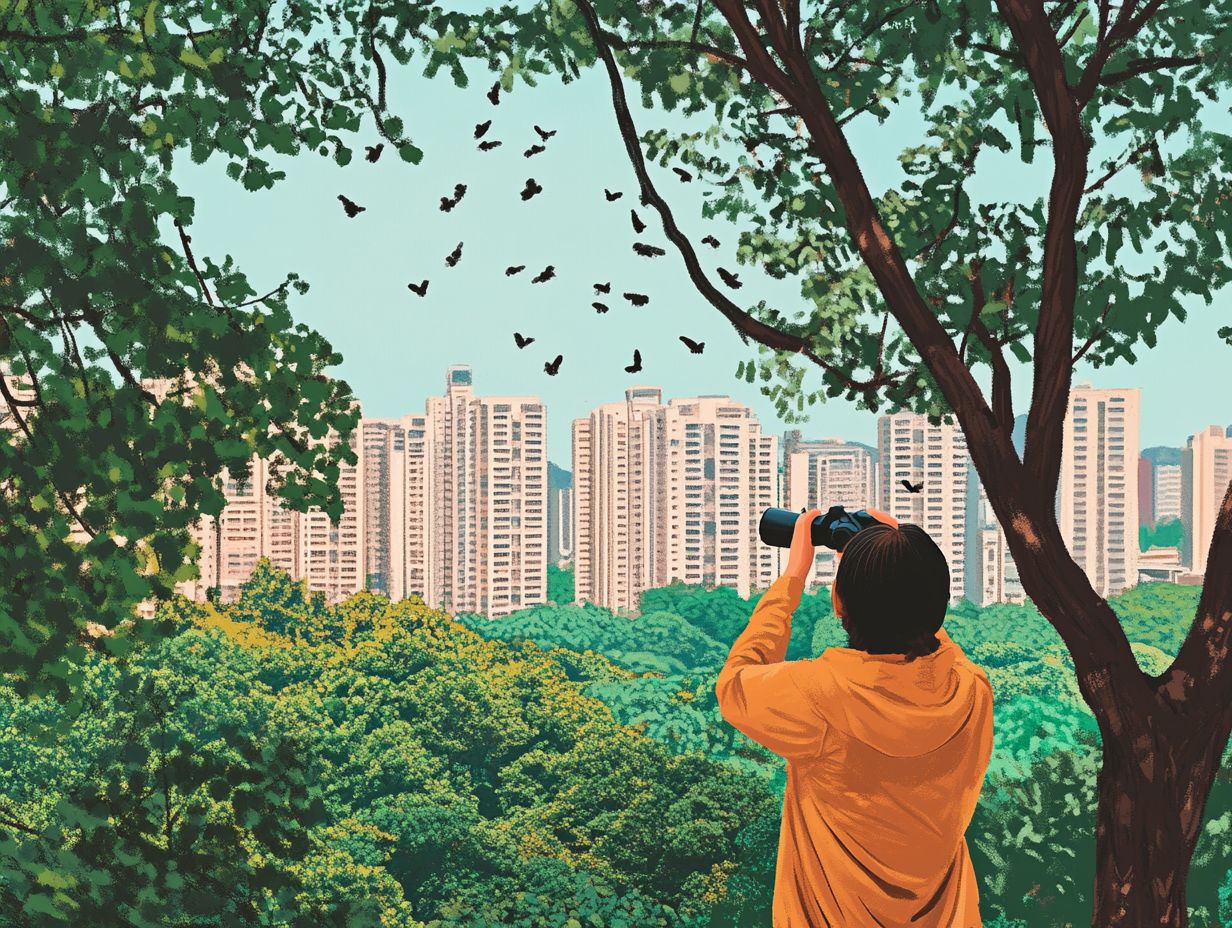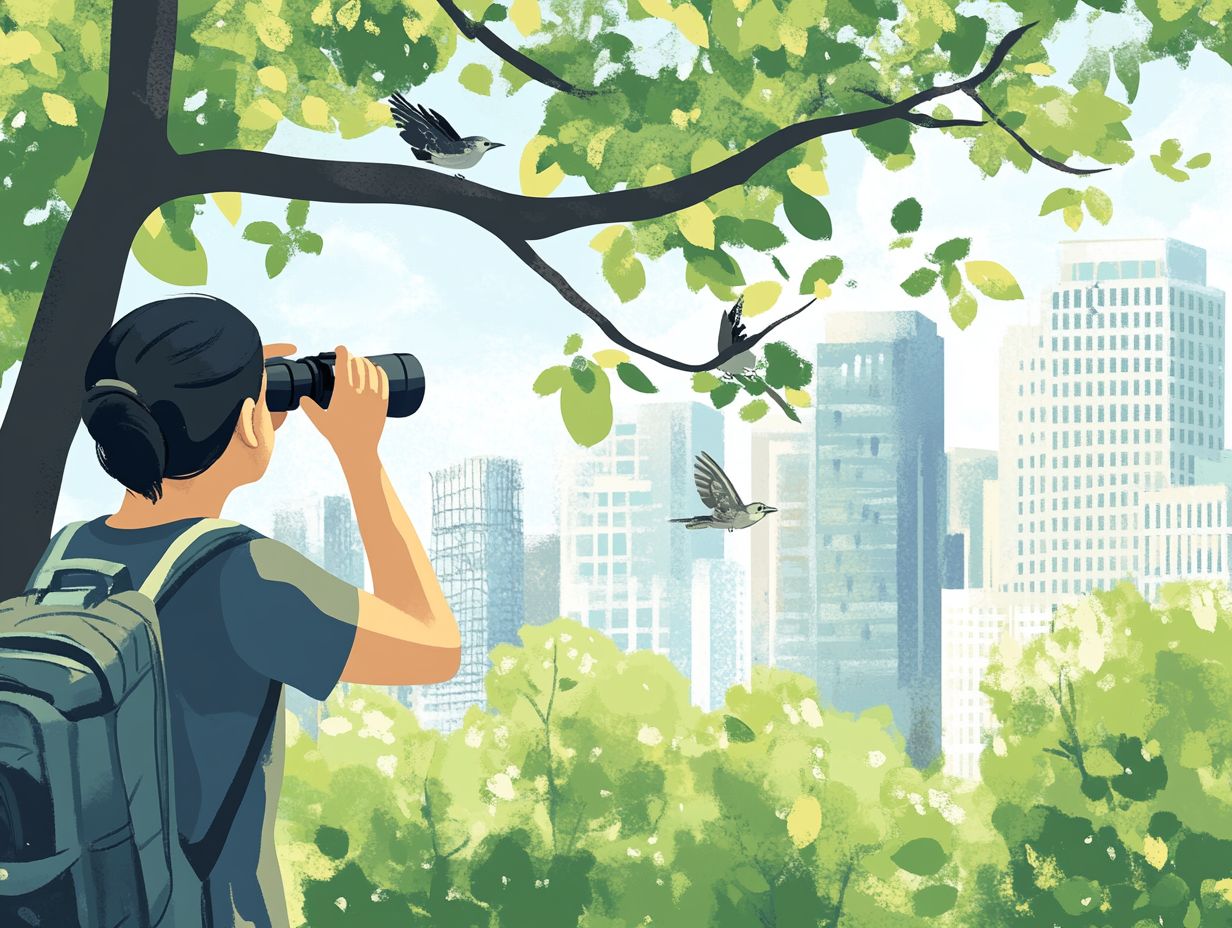How to Spot Birds in Urban Areas?
Cities are alive with activity, and surprisingly, they host a rich variety of birds just waiting to be discovered!
Engaging in birdwatching within the city not only reconnects you with nature, but it also plays a vital role in conservation efforts. This guide will equip you with essential tools for spotting birds, highlight common urban species you should keep an eye out for, and share effective techniques for observing these captivating creatures amidst the city’s hustle and bustle.
You ll navigate the unique challenges faced by urban birdwatchers and explore how you can contribute to citizen science initiatives. Embrace the joy of urban birdwatching and learn how to enhance your experience in the concrete jungle!
Contents
Key Takeaways:

- Grab vital gear like binoculars to spot urban birds easily.
- Take note of common urban bird species such as pigeons, sparrows, and crows, and their distinct characteristics for easier identification.
- Use techniques like staying still and quiet, and scanning the tree canopy and building rooftops to spot and observe birds in busy urban areas.
Why Birdwatching in Urban Areas is Important
Birdwatching in cities is more exciting than ever! It serves as a vital avenue for wildlife conservation while deepening your understanding of urban ecosystems the way nature exists in cities. Cities might often seem like barren landscapes devoid of nature, but in reality, they brim with avian diversity, offering you unique opportunities to observe a variety of urban birds from sparrows and feral pigeons to impressive birds of prey like peregrine falcons.
Engaging in urban birdwatching fosters a meaningful connection between you and your natural surroundings, while also supporting local initiatives aimed at creating bird-friendly landscapes and enhancing green spaces.
Join community birdwatching events to learn more about local birds and understand the significance of preserving birding patches those small green areas that provide essential resources for wildlife. These gatherings not only educate you about the specific species that inhabit your city but also encourage community engagement, inspiring you and others to advocate for conservation efforts.
By observing nature in urban environments, you become more attuned to ecological issues, which can heighten your appreciation for biodiversity. This shift in perspective is crucial for inspiring collective action, ultimately benefiting both your local community and the broader environment.
Equipment and Tools for Bird Spotting
Equipping yourself with the right tools for bird spotting can elevate your urban birdwatching adventures and aid you in identifying various species thriving in city environments.
Essential accessories include:
- Quality binoculars that bring urban birds into sharper focus,
- Field guides that assist with species identification, and
- Birdwatching apps like iNaturalist and other birdwatching resources to document your encounters.
Establishing bird feeders in local parks or even your own backyard can attract common urban dwellers such as sparrows and feral pigeons, allowing you to hone your birdwatching skills.
Essential Gear for Urban Birdwatching
Essential gear for urban birdwatching includes high-quality binoculars, field guides, and various accessories that can significantly elevate your birdwatching success. With the right binoculars, you’ll be able to observe birds from a distance without disturbing them. A well-chosen field guide provides crucial information for accurate species identification.
Additional tools such as notebooks for recording sightings and suitable clothing for different urban habitats will further enrich your experience.
Investing in a sturdy pair of binoculars, ideally with a magnification of 8x to 10x, allows you to spot subtle details like the colors and designs of feathers and behaviors that might otherwise go unnoticed. A reputable field guide not only aids in identification but also enhances your understanding of species habitats and migratory patterns, making your birdwatching experience even more rewarding.
Carrying a notebook encourages you to log your observations meticulously, fostering a deeper connection with your environment. Wearing the right clothing helps you adapt to urban settings, providing both comfort and camouflage, enabling you to blend into your surroundings and boosting your chances of spotting elusive species.
These essential accessories are invaluable for both novice and seasoned birdwatchers, ensuring that every outing is a memorable adventure.
Identifying Common Urban Birds

Spotting common urban birds is an exciting adventure that connects you with the vibrant life around you. Familiarity with species like sparrows, feral pigeons, and majestic birds of prey such as buzzards and red kites can significantly enhance your birdwatching experience.
Employing effective birdwatching tips and techniques can refine your skills in identifying various species. You ll gain insight into their behaviors and appreciate the intricate details of their habitats.
Species to Look Out For
When you re birdwatching in urban areas, keep an eye out for fascinating species like the familiar feral pigeon, the elusive peregrine falcon, or seasonal visitors such as the woodcock. Understanding their migration patterns and preferred habitats is essential for successfully spotting these birds during your adventures.
Feral pigeons, often roosting on ledges or foraging in parks, are true urban survivors. They adapt seamlessly to bustling environments, making them a common sight all year round. Meanwhile, the peregrine falcon reigns as the master of the urban sky, frequently hunting from high perches, especially during breeding season in spring when they re most active.
As seasons change, so does the visibility of different species. Don t miss the chance to spot the captivating woodcock during migration; its unique display, known as the ‘sky dance’, is a breathtaking sight as it ascends into the evening air. Each season brings its own stars, allowing you to anticipate and enhance your excursions in pursuit of these remarkable birds.
Techniques for Spotting Birds in Urban Areas
Utilizing effective birdwatching techniques for spotting birds in urban environments can elevate your birdwatching experiences, deepening your understanding of avian behavior and enriching your appreciation for the diverse birdlife surrounding you.
Approaches like remaining still, utilizing natural cover, and keenly observing feeding patterns can significantly aid in locating urban birds in their city habitats.
Connecting with local bird groups will refine your skills and offer invaluable insights into effective birdwatching strategies.
Tips for Finding and Observing Birds
To elevate your urban birdwatching experience, embracing practical tips for finding and observing birds can make all the difference. By identifying popular birdwatching spots like local parks, green spaces, and areas with bird feeders, you significantly increase your chances of spotting a variety of species.
Cultivating patience and maintaining a quiet demeanor while you explore these environments deepens your connection with nature. This also enhances the likelihood of delightful bird encounters during your adventures.
Timing is everything. Early mornings or late afternoons are your golden hours. Birds tend to be most active then.
Observing the specific behaviors of different species like how they look for food or their nesting habits leads you to fruitful locations for sightings. Binoculars are your best friends in this endeavor, providing a closer look at the intricate details that make each bird truly unique.
Approaching your outings with mindfulness taking a moment to breathe, listen, and fully immerse yourself in your surroundings can transform a casual excursion into a rewarding journey of discovery. This enriches your overall birdwatching experience.
Challenges and Solutions for Urban Birdwatching

Urban birdwatching offers its own set of challenges, with noise and distractions often obstructing your efforts to observe wildlife. Factors like traffic, construction, and the hustle and bustle of city life can make it tricky to spot and identify birds in their natural habitats.
However, by adopting strategies like venturing out during quieter times and joining community events focused on wildlife conservation, you can effectively mitigate these obstacles and elevate your overall birdwatching experience.
Dealing with Noise and Distractions
Dealing with noise and distractions is a common concern for anyone immersed in urban birdwatching. There are several techniques you can employ to enhance your observation skills in these lively environments and connect with the urban ecology.
One effective approach is to visit parks or green spaces during the early morning hours when both human activity and urban sounds are at their lowest. Using high-quality binoculars allows you to focus on distant birds and minimizes the need to move closer, reducing exposure to disruptions.
Another strategy is to wear comfortable, muted clothing that helps you blend into your surroundings. This ensures you remain inconspicuous. Using sound-absorbing materials, such as sitting on a soft blanket, can significantly reduce disturbances from your movements.
Practicing patience and mindfulness will not only heighten your awareness of the avian world but will also enrich your overall experience as you observe birds amid the urban hustle and bustle.
Recording and Reporting Bird Sightings
Recording and reporting your bird sightings is an essential aspect of urban birdwatching. It serves both your personal growth and larger citizen science initiatives focused on wildlife conservation. When you document your observations whether in journals or through birdwatching apps like iNaturalist you re honing your skills and providing invaluable data to the birdwatching community.
Join local birdwatching events to connect with fellow enthusiasts and enhance your sightings. By tapping into local resources, you can significantly amplify the impact of your findings.
Join the Adventure of Citizen Science!
Contributing to citizen science projects offers great enjoyment and gives you the power to play an active role in wildlife conservation as an urban birdwatcher. By using birdwatching apps like iNaturalist, you can effortlessly report your sightings and contribute to broader conservation initiatives.
Engaging in these projects enriches your birdwatching experience and provides essential data that informs conservation strategies and policies regarding urban wildlife.
To embark on this journey, join local birding groups or online forums dedicated to citizen science, where you can share your observations and absorb knowledge from seasoned participants. Attending workshops or community events will further equip you with the skills necessary for effective data collection.
By immersing yourself in these initiatives, you’ll cultivate a deeper connection with nature while building a sense of community with like-minded individuals.
The benefits extend well beyond personal development; your participation raises awareness about urban biodiversity and fuels collective action in conservation efforts. Ultimately, this supports the ecosystem and strengthens the social fabric of your community.
Your Birdwatching Questions Answered!

How do I spot birds in urban areas?
To spot birds in urban areas, start by looking for green spaces such as parks or gardens, which are more likely to attract birds. Check out areas with trees, bushes, or other vegetation where birds might perch or nest.
When is the best time to spot birds?
Early morning and late afternoon are typically the best times for bird spotting in urban areas. Birds tend to be more active during these periods, making them easier to see. The lighting during these times helps you see their feather colors and patterns clearly.
What types of birds can I expect to see?
A variety of bird species can be found in urban areas. Common ones include pigeons, sparrows, crows, and seagulls. However, you may also spot unique species such as hawks, hummingbirds, or even rare migratory birds passing through.
What behaviors should I look for when spotting birds?
Keep an eye out for birds flying low to the ground or perched on buildings or streetlights. You may also hear their calls or see them foraging for food in bushes or on the ground.
What should I bring with me?
It’s always a good idea to bring a pair of binoculars when bird spotting in urban areas. This allows you to get a closer look at birds that may be far away or perched high up. Consider bringing a bird guide or using a bird identification app on your phone to help identify the species you spot.
Is it important to be quiet while bird spotting?
Yes, remaining quiet and still is crucial when bird spotting. Birds can be easily scared off by loud noises and sudden movements, so it’s best to be as quiet and inconspicuous as possible. This will increase your chances of spotting and observing different bird species.
Ready to start your birdwatching journey? Grab your binoculars and join a local group today!






